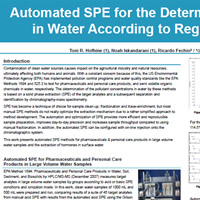
AUTOMATED SPE FOR THE DETERMINATION OF CONTAMINANTS IN WATER ACCORDING TO REGULATORY REQUIREMENTS Toni R. Hofhine (1), Noah Iskandarani (1), Ricardo Fechio (2) 1) Gilson Inc., USA, (2) Nova Analítica, SP, Brazil |
Resumo do Pôster:Contamination of clean water sources causes impact on the agricultural industry and natural resources; ultimately affecting both humans and animals. With a constant concern because of this, the US Environmental Protection Agency (EPA) has implemented pollution control programs and water quality standards like the EPA Methods 1694 and 525.3 to test for pharmaceuticals and personal care products, and semivolatile organic chemicals in water, respectively. The determination of the pollutant concentrations in water by these methods is based on a solid phase extraction (SPE) of the target analytes and a subsequent separation and identification by chromatography-mass spectrometry. SPE has become a technique of choice for sample clean-up, fractionation and trace-enrichment, but most manual SPE methods do not really optimize the extraction mechanism due to a rather simplified approach to method development. The automation and optimization of SPE provides more efficient and reproducible sample preparation, improves day-to-day precision and increases sample throughput compared to using manual fractionation. In addition, the automated SPE can be configured with on-line injection onto the chromatographic system. The recovery values obtained for automated SPE samples were within the expected by the EPA Methods. The automation of the SPE process increased sample throughput, reduced the solvent usage and reduced the potential errors that may occur in during manual processing of samples. This study included researching any carryover from the target analytes. Mean sample values showed either no peaks detected or less than detectable reporting limits for all target analytes. |
